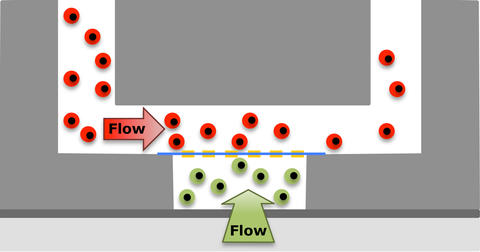Summary
The use of tissue/organ-on-a-chip systems is limited to endpoint and destructive measurements. Integration of electronic elements in these systems have proven to be a huge challenge and only a few demonstrations have been shown. Contrary to endpoint biochemical methods, continuous electronic monitoring of cellular behavior provides an approach for real-time and non-destructive methods that support acute and chronic studies within the same assay. Therefore, we are developing microfluidic-based tissue/organ-on-a-chip devices with embedded electronic elements. We aim to measure cell migration rate, which we hypothesize can be correlated with aggressiveness of cancer cells, and cardiac cell beating changes, which can indicate progression of cell function failure, such as during myocardial infarction. Electronic elements in our systems are directly fabricated on porous membranes that serve as adhesion surfaces where cultured cells are interrogated in a controlled microenvironment. Impedance and action (field) potentials can be measured continuously to provide real-time information of the physiological state of the cell. Our goal is to fabricate systems and demonstrate their efficacy in delivering real-time, continuous monitoring of cellular responses under stress and disease conditions. The end goal is to provide an in vitro measurement system to determine cellular responses toward therapeutic molecules.
Description

Figure 1. Microfluidic tissue/organ on a chip system with embedded electrodes (yellow) on both sides of the porous membrane (blue). Liver cancer cells (red) and endothelial cells (green) can be trapped while flowing through the channels (white) on each side of the membrane to form a tissue-type cell co-culture. The two cell types are trapped using dielectrophoresis. They are physically separated by the membrane but can interact and communicate with each other through secreted cell signals via the pores in the membrane.
We apply our expertise in micro/nanofabrication, electrokinetics and cell-based assays to develop bioelectronic sensors in microfluidic platforms. We are working on a platform that entraps cells for electrochemical monitoring in an environment that has mechanical properties more similar to those experienced by the cells in vivo. We will employ impedance measurements to determine cell migration characteristics of cancer cells in a 3D model system, and bioelectric activity of cardiac cells under induced stress conditions. Current efforts in our lab have produced a platform with electrodes on a porous membrane for dielectrophoretic trapping as well as impedance measurements of cell migration. Development of these organ-on-a-chip devices with embedded electronic capabilities will provide tools to help develop regenerative medicine approaches and cell-based diagnostics for heart disease and cancer.
Research Opportunities
NRC/NIST Postdoctoral Fellowship
- 2-year fellowship
- Sponsored by the National Research Council
- Application requires an original research proposal
- Application deadlines: February 1 and August 1
- Stipend - $ 74,950/year; Travel Allotment - $3,000; Other benefits
- Application deadlines are Feb. 1 and Aug. 1 of each year
- US citizenship required
Please contact Dr. Darwin R. Reyes at darwin.reyes [at] nist.gov (darwin[dot]reyes[at]nist[dot]gov) if interested in applying for this fellowship.
- Dr. Reyes NRC-NIST Research Opportunity Description
- NIST NRC Postdoctoral Research Associateships Program
- Research Associateship Programs - National Academies of Sciences, Engineering and Medicine
INTERACTION WITH INDUSTRY AND OTHER STAKEHOLDERS
Standardizing aspects such as vocabulary, protocols, measurements, and materials are required to promote U.S. innovation and industrial competitiveness of Organ on a Chip (OoC) and other microfluidics-based technologies. In collaboration with other federal agencies and industry stakeholders, we are working towards developing guidelines and standards for components and other engineering aspects of microfluidic systems and OoC platforms. We are working towards these goals with partners like the Microfluidics Association, FDA, and companies developing OoC and OoC-related products.
Selected Publications
- B.J. Nablo and D.R. Reyes, Dual Dielectrophoretic Assembly of Co-Cultures for the Study of Cell Migration Induced by Cell-Cell Interactions, In Proceedings of Micro Total Analysis Systems 2021, 343-344.
-
B.J. Nablo, J.-J. Ahn, K. Bhadriraju, J.M. Lee, D.R. Reyes, Lens-Free Imaging as a Sensor for Dynamic Cell Viability Detection Using the Neutral Red Uptake Assay, ACS Applied Bio Materials, 2020, 3, 6633– 6638.
- S. Minnikanti, J.J. Ahn, Y. Obeng and D.R. Reyes, Generating Multiscale Gold Nanostructures on Glass without Sidewall Deposits Using Minimal Dry Etching Steps, ACS Nano 2019, 13, 3924-3930.

